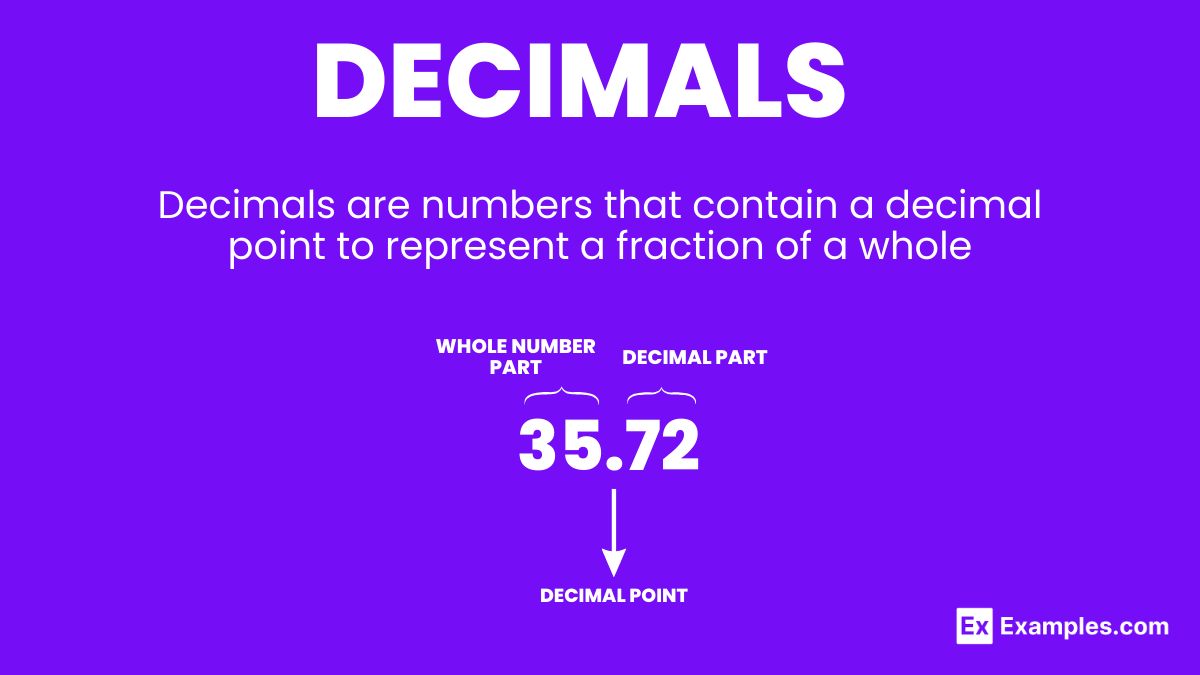What is the decimal representation of 3/4?
0.75
0.70
0.80
0.85


Decimals are a fundamental concept in mathematics, representing numbers between whole numbers. Understanding decimals is crucial for students to excel in math, especially in topics like measurement, money, and fractions. This guide breaks down decimals into simple, easy-to-grasp concepts with practical examples, helping teachers convey these ideas effectively to students. Whether it’s adding, subtracting, multiplying, or dividing, decimals play a key role in everyday math applications, making this guide essential for classroom success.
Decimals are numbers that contain a decimal point to represent a fraction of a whole. Unlike whole numbers, decimals allow for greater precision by dividing a number into parts smaller than one. Think of them as an extension of the place value system, where each position to the right of the decimal point represents tenths, hundredths, thousandths, and so on. For example, the decimal 0.5 signifies half of a whole, and 1.75 represents one whole plus three-quarters of another. Understanding decimals is vital for accurate measurement, financial calculations, and scientific data representation.

Decimal numbers are a crucial part of mathematics, representing values between whole numbers. They consist of a whole number part, a decimal point, and a fractional part.
Each type plays a specific role in mathematics and real-world applications, helping students understand the nuances of numerical values.
The place value system in decimals extends the concept of whole numbers to include positions to the right of the decimal point. Each place represents a fraction of ten. For instance, in the decimal number 3.142, the 1 signifies one-tenth (0.1), the 4 represents four one-hundredths (0.04), and the 2 stands for two one-thousandths (0.002). Understanding place value is essential for performing arithmetic operations with decimals and helps students grasp the concept of magnitude and precision in numerical data.
Decimals exhibit unique properties that make them fundamental in mathematics. Key properties include:
These properties ensure consistency and predictability in calculations, aiding in the teaching and understanding of mathematical concepts involving decimals.
Performing arithmetic operations on decimals is fundamental in mathematics, enabling precise calculations. These operations include addition, subtraction, multiplication, and division, each requiring attention to decimal place alignment for accurate results.
Converting decimals to fractions involves understanding the place value of the decimal and simplifying the resulting fraction to its lowest terms.
These examples illustrate the direct relationship between decimals and fractions, emphasizing the importance of place value and simplification in conversions.
The Decimal Place Value Chart is a tool used to understand and visualize the position and value of digits in a decimal number. It helps in breaking down the number into its constituent parts, such as tenths, hundredths, thousandths, etc., enhancing clarity and comprehension.
The Decimal Place Value Chart is instrumental in teaching the concept of decimals, offering a visual representation of how each digit’s position affects its value. It underscores the relationship between places to the left and right of the decimal point, facilitating a deeper understanding of decimals.
This comprehensive guide outlines the significance and utility of the Decimal Place Value Chart in teaching and understanding decimals, providing a solid foundation for arithmetic operations and conceptual clarity.
Decimal problems involve scenarios where operations on decimal numbers are required to find solutions. These can range from basic arithmetic to more complex applications in real-world contexts, helping students to understand decimals’ practicality and develop their numerical skills.
Decimals play a vital role in mathematics and everyday life, offering precision in measurements, calculations, and financial transactions. Understanding their properties, operations, and applications enhances numerical literacy and problem-solving skills. This guide has explored various aspects of decimals, from basic concepts to real-world applications, aiming to provide a comprehensive understanding that empowers both teachers and students to navigate the world of decimals with confidence and clarity.
Text prompt
Add Tone
Decimal Problems
Arithmetic Operations on Decimals
What is the decimal representation of 3/4?
0.75
0.70
0.80
0.85
Which decimal is equivalent to 0.6?
3/5
1/2
2/3
1/4
What is 7.8 rounded to the nearest whole number?
7
8
9
10
How do you convert 0.125 to a fraction?
1/8
1/4
1/10
1/2
Which of the following is the decimal form of 7/20?
0.35
0.30
0.40
0.45
What is the result of adding 4.25 and 3.75?
7.00
8.00
7.50
8.50
If you subtract 0.4 from 2.3, what is the result?
1.8
1.9
1.7
1.6
What is 0.875 expressed as a fraction in simplest form?
7/8
3/4
5/6
9/10
What is the product of 0.6 and 0.4?
0.20
0.24
0.26
0.28
Which decimal is greater: 0.75 or 0.7?
0.75
0.7
They are equal
Cannot be determined
Before you leave, take our quick quiz to enhance your learning!

